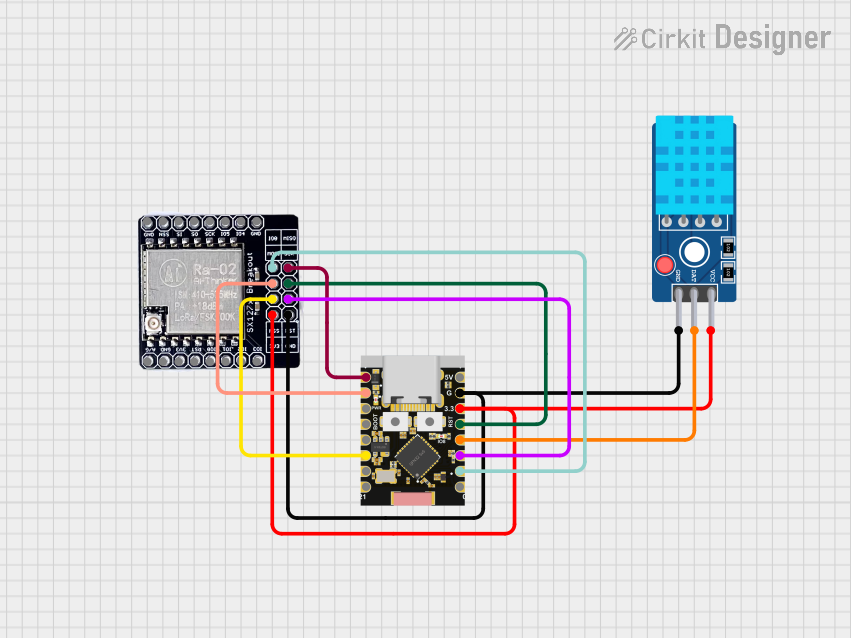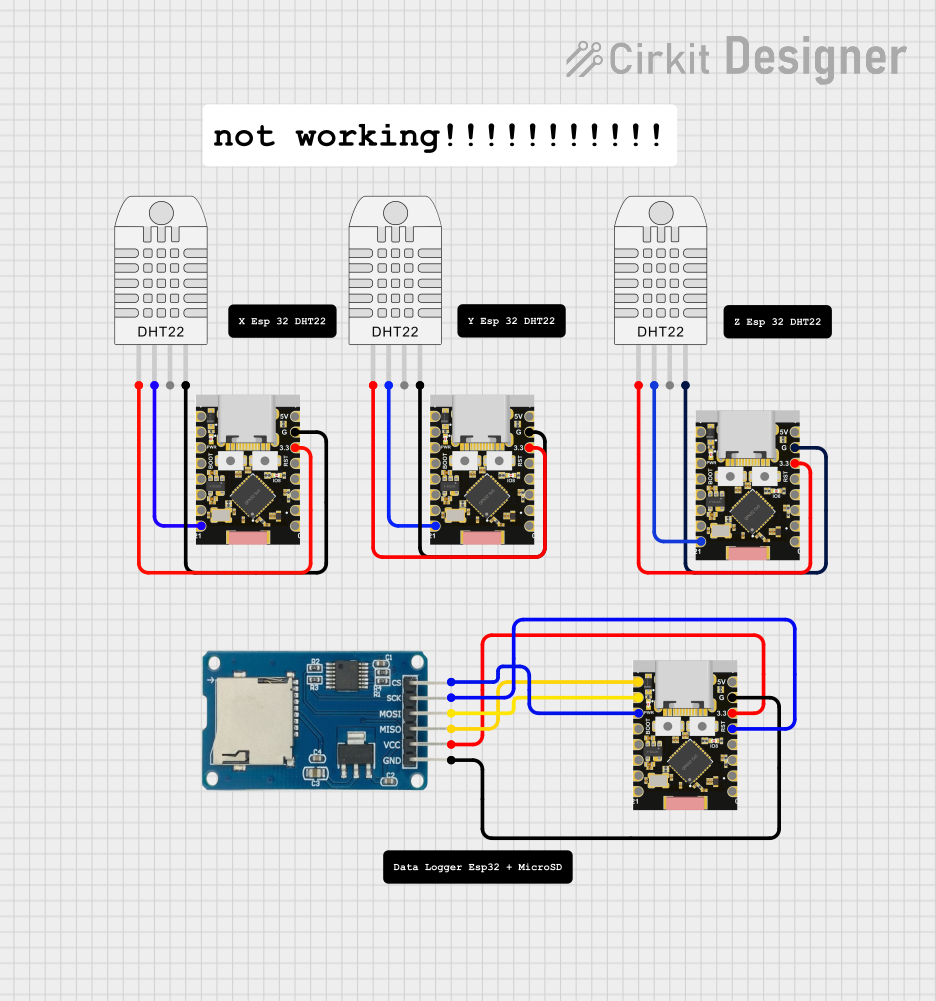
How to Use ESP32-C3 Supermini: Examples, Pinouts, and Specs

 Design with ESP32-C3 Supermini in Cirkit Designer
Design with ESP32-C3 Supermini in Cirkit DesignerIntroduction
The ESP32-C3 Supermini is a compact, low-power microcontroller designed for Internet of Things (IoT) applications. It features integrated Wi-Fi and Bluetooth Low Energy (BLE) capabilities, making it ideal for wireless communication in smart devices. Built on a RISC-V architecture, the ESP32-C3 Supermini offers efficient processing, enhanced security features, and a small form factor, making it suitable for space-constrained designs.
Explore Projects Built with ESP32-C3 Supermini

 Open Project in Cirkit Designer
Open Project in Cirkit Designer
 Open Project in Cirkit Designer
Open Project in Cirkit Designer
 Open Project in Cirkit Designer
Open Project in Cirkit Designer
 Open Project in Cirkit Designer
Open Project in Cirkit DesignerExplore Projects Built with ESP32-C3 Supermini

 Open Project in Cirkit Designer
Open Project in Cirkit Designer
 Open Project in Cirkit Designer
Open Project in Cirkit Designer
 Open Project in Cirkit Designer
Open Project in Cirkit Designer
 Open Project in Cirkit Designer
Open Project in Cirkit DesignerCommon Applications and Use Cases
- Smart home devices (e.g., smart plugs, thermostats, and lighting systems)
- Wearable technology
- Industrial IoT sensors and controllers
- Wireless data logging and monitoring
- Low-power, battery-operated devices
- Prototyping and development of IoT solutions
Technical Specifications
The ESP32-C3 Supermini is packed with features that make it versatile and powerful for a wide range of applications. Below are its key technical specifications:
| Specification | Details |
|---|---|
| Microcontroller Core | RISC-V single-core processor, up to 160 MHz |
| Flash Memory | 4 MB (varies by model) |
| RAM | 400 KB SRAM |
| Wi-Fi | IEEE 802.11 b/g/n (2.4 GHz) |
| Bluetooth | Bluetooth 5.0 Low Energy (BLE) |
| GPIO Pins | 15 GPIO pins (multiplexed with other functions) |
| Operating Voltage | 3.3V |
| Input Voltage Range | 5V (via USB) or 3.3V (via external power supply) |
| Power Consumption | Ultra-low power consumption in deep sleep mode (as low as 5 µA) |
| Interfaces | SPI, I2C, UART, PWM, ADC (12-bit), DAC |
| Security Features | Secure boot, flash encryption, and hardware cryptographic accelerators |
| Dimensions | Approximately 18 mm x 25 mm |
Pin Configuration and Descriptions
The ESP32-C3 Supermini has a compact pinout. Below is a table describing the key pins:
| Pin Name | Type | Description |
|---|---|---|
| 3V3 | Power | 3.3V power supply input/output |
| GND | Power | Ground connection |
| GPIO0 | GPIO/Boot | General-purpose I/O pin; also used for boot mode selection |
| GPIO1 | GPIO/UART TX | General-purpose I/O pin; UART transmit (TX) |
| GPIO2 | GPIO/UART RX | General-purpose I/O pin; UART receive (RX) |
| GPIO3 | GPIO | General-purpose I/O pin |
| GPIO4 | GPIO/I2C SDA | General-purpose I/O pin; I2C data line |
| GPIO5 | GPIO/I2C SCL | General-purpose I/O pin; I2C clock line |
| GPIO6-11 | GPIO/SPI | General-purpose I/O pins; can be used for SPI communication |
| ADC1 | Analog Input | 12-bit ADC input |
| EN | Enable | Chip enable pin; active high |
| RST | Reset | Reset pin; active low |
| USB D+ | USB Data | USB data positive line |
| USB D- | USB Data | USB data negative line |
Usage Instructions
How to Use the ESP32-C3 Supermini in a Circuit
Powering the Module:
- Use a 5V USB power source or provide a regulated 3.3V to the 3V3 pin.
- Ensure proper grounding by connecting the GND pin to the circuit ground.
Programming the Module:
- The ESP32-C3 Supermini can be programmed using the Arduino IDE or the ESP-IDF (Espressif IoT Development Framework).
- Connect the module to your computer via USB. Select the appropriate board and port in the IDE.
Connecting Peripherals:
- Use GPIO pins for digital input/output.
- For analog input, connect sensors to the ADC1 pin.
- Use I2C (GPIO4 and GPIO5) or SPI (GPIO6-11) for communication with external devices.
Flashing Code:
- Hold the GPIO0 pin low while resetting the module to enter bootloader mode.
- Upload your code using the IDE.
Important Considerations and Best Practices
- Voltage Levels: Ensure all connected peripherals operate at 3.3V logic levels to avoid damaging the module.
- Deep Sleep Mode: Use deep sleep mode to minimize power consumption in battery-powered applications.
- Antenna Placement: Avoid placing metal objects near the onboard antenna to ensure optimal Wi-Fi and Bluetooth performance.
- Pull-up Resistors: Use pull-up resistors on I2C lines (SDA and SCL) if not already included in your circuit.
Example Code for Arduino UNO Integration
Below is an example of how to use the ESP32-C3 Supermini to read a temperature sensor and send the data over Wi-Fi:
#include <WiFi.h> // Include the Wi-Fi library
// Wi-Fi credentials
const char* ssid = "Your_SSID"; // Replace with your Wi-Fi SSID
const char* password = "Your_Password"; // Replace with your Wi-Fi password
void setup() {
Serial.begin(115200); // Initialize serial communication
WiFi.begin(ssid, password); // Connect to Wi-Fi
// Wait for connection
while (WiFi.status() != WL_CONNECTED) {
delay(1000);
Serial.println("Connecting to Wi-Fi...");
}
Serial.println("Connected to Wi-Fi!");
}
void loop() {
// Example: Read a sensor value (replace with actual sensor code)
int sensorValue = analogRead(ADC1); // Read from ADC1 pin
Serial.print("Sensor Value: ");
Serial.println(sensorValue);
delay(1000); // Wait 1 second before the next reading
}
Troubleshooting and FAQs
Common Issues and Solutions
Module Not Detected by Computer:
- Ensure the USB cable is functional and supports data transfer.
- Check if the correct drivers for the ESP32-C3 are installed on your computer.
Wi-Fi Connection Fails:
- Verify the SSID and password are correct.
- Ensure the Wi-Fi network operates on the 2.4 GHz band (not 5 GHz).
Code Upload Fails:
- Ensure the module is in bootloader mode by holding GPIO0 low during reset.
- Check the selected board and port in the Arduino IDE.
Unstable Operation:
- Verify the power supply provides sufficient current (at least 500 mA).
- Avoid noisy power sources that may cause instability.
FAQs
Can the ESP32-C3 Supermini operate on battery power?
Yes, it is designed for low-power operation and can run on batteries. Use deep sleep mode to extend battery life.What is the maximum range of Wi-Fi and Bluetooth?
The range depends on environmental factors, but typically Wi-Fi can reach up to 50 meters indoors, and Bluetooth can reach up to 10 meters.Can I use the ESP32-C3 Supermini with other development boards?
Yes, it can communicate with other boards like Arduino via UART, I2C, or SPI.
This concludes the documentation for the ESP32-C3 Supermini.